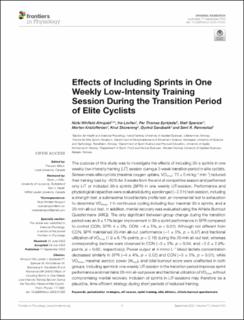| dc.description.abstract | The purpose of this study was to investigate the effects of including 30-s sprints in one weekly low-intensity training (LIT) session during a 3-week transition period in elite cyclists. Sixteen male elite cyclists (maximal oxygen uptake, VO2max: 72 ± 5 ml·kg−1·min−1) reduced their training load by ~60% for 3 weeks from the end of competitive season and performed only LIT or included 30-s sprints (SPR) in one weekly LIT-session. Performance and physiological capacities were evaluated during a prolonged (~2.5 h) test-session, including a strength test, a submaximal blood lactate profile test, an incremental test to exhaustion to determine VO2max, 1 h continuous cycling including four maximal 30-s sprints, and a 20-min all-out test. In addition, mental recovery was evaluated using the Athlete Burnout Questionnaire (ARQ). The only significant between-group change during the transition period was an 8 ± 11% larger improvement in 30-s sprint performance in SPR compared to control (CON; SPR: 4 ± 5%, CON: −4 ± 5%, p = 0.01). Although not different from CON, SPR maintained 20-min all-out performance (−1 ± 5%, p = 0.37) and fractional utilization of VO2max (1.9 ± 6.1%-points, p = 0.18) during the 20-min all-out test, whereas corresponding declines were observed in CON (−3 ± 5%, p = 0.04, and −2.5 ± 2.9%- points, p = 0.02, respectively). Power output at 4 mmol·L−1 blood lactate concentration decreased similarly in SPR (−4 ± 4%, p = 0.02) and CON (−5 ± 5%, p = 0.01), while VO2max, maximal aerobic power (Wmax), and total burnout score were unaffected in both groups. Including sprints in one weekly LIT-session in the transition period improves sprint performance and maintains 20-min all-out power and fractional utilization of VO2max without compromising mental recovery. Inclusion of sprints in LIT-sessions may therefore be a plausible, time-efficient strategy during short periods of reduced training. | en_US |

